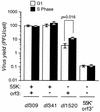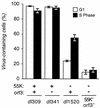E4orf3 is necessary for enhanced S-phase replication of cell cycle-restricted subgroup C adenoviruses
- PMID: 12857931
- PMCID: PMC165245
- DOI: 10.1128/jvi.77.15.8593-8595.2003
E4orf3 is necessary for enhanced S-phase replication of cell cycle-restricted subgroup C adenoviruses
Abstract
E1B-55K-mutant or E4orf6-mutant adenoviruses replicate more effectively after infecting cells in S phase than after infecting cells in G(1). Enhanced S-phase replication of the E4orf6-mutant viruses requires the E4orf3 gene. This report demonstrates that the E4orf3 gene is also required for enhanced S-phase replication of the E1B-55K-mutant virus.
Figures



Similar articles
-
Diverse roles for E4orf3 at late times of infection revealed in an E1B 55-kilodalton protein mutant background.J Virol. 2004 Sep;78(18):9924-35. doi: 10.1128/JVI.78.18.9924-9935.2004. J Virol. 2004. PMID: 15331726 Free PMC article.
-
Roles for the E4 orf6, orf3, and E1B 55-kilodalton proteins in cell cycle-independent adenovirus replication.J Virol. 1999 Sep;73(9):7474-88. doi: 10.1128/JVI.73.9.7474-7488.1999. J Virol. 1999. PMID: 10438837 Free PMC article.
-
Adenovirus replaces mitotic checkpoint controls.J Virol. 2015 May;89(9):5083-96. doi: 10.1128/JVI.00213-15. Epub 2015 Feb 18. J Virol. 2015. PMID: 25694601 Free PMC article.
-
Mutant adenoviruses selectively replication-competent in tumor cells.Adv Exp Med Biol. 2000;465:65-71. doi: 10.1007/0-306-46817-4_7. Adv Exp Med Biol. 2000. PMID: 10810616 Review. No abstract available.
-
Epigenetics and the dynamics of chromatin during adenovirus infections.FEBS Lett. 2019 Dec;593(24):3551-3570. doi: 10.1002/1873-3468.13697. Epub 2019 Dec 15. FEBS Lett. 2019. PMID: 31769503 Free PMC article. Review.
Cited by
-
The adenoviral E4orf3/4 is a regulatory polypeptide with cell transforming properties in vitro.Tumour Virus Res. 2023 Jun;15:200254. doi: 10.1016/j.tvr.2023.200254. Epub 2023 Jan 25. Tumour Virus Res. 2023. PMID: 36707050 Free PMC article.
-
Temporal regulation of the Mre11-Rad50-Nbs1 complex during adenovirus infection.J Virol. 2009 May;83(9):4565-73. doi: 10.1128/JVI.00042-09. Epub 2009 Feb 25. J Virol. 2009. PMID: 19244322 Free PMC article.
-
The adenovirus E4 ORF3 protein binds and reorganizes the TRIM family member transcriptional intermediary factor 1 alpha.J Virol. 2007 Apr;81(8):4264-71. doi: 10.1128/JVI.02629-06. Epub 2007 Feb 7. J Virol. 2007. PMID: 17287283 Free PMC article.
-
PML Alternative Splice Products Differentially Regulate HAdV Productive Infection.Microbiol Spectr. 2022 Aug 31;10(4):e0078522. doi: 10.1128/spectrum.00785-22. Epub 2022 Jun 14. Microbiol Spectr. 2022. PMID: 35699431 Free PMC article.
-
E1B and E4 oncoproteins of adenovirus antagonize the effect of apoptosis inducing factor.Virology. 2014 May;456-457:205-19. doi: 10.1016/j.virol.2014.03.010. Epub 2014 Apr 15. Virology. 2014. PMID: 24889240 Free PMC article.
References
-
- Barker, D. D., and A. J. Berk. 1987. Adenovirus proteins from both E1B reading frames are required for transformation of rodent cells by viral infection and DNA transfection. Virology 156:107-121. - PubMed
-
- Dery, C. V., C. H. Herrmann, and M. B. Mathews. 1987. Response of individual adenovirus promoters to the products of the E1A gene. Oncogene 2:15-23. - PubMed
Publication types
MeSH terms
Substances
Grants and funding
LinkOut - more resources
Full Text Sources
Other Literature Sources

